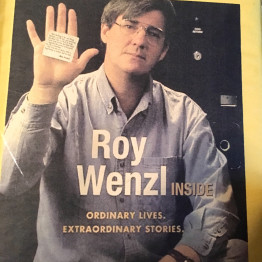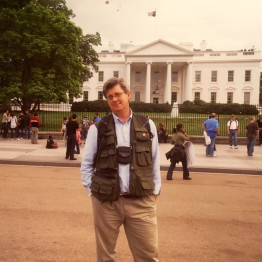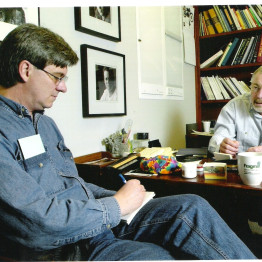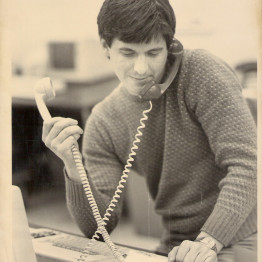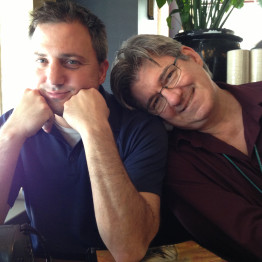Wenzl, Roy
Roy Wenzl started his first job in 1977 at The Kansas City Star. He learned from great reporters and editors like Gary Rice, Greg Edwards and Mike Waller, who taught investigation, tenacity, and the addictive thrill of deadline-driven reporting. He learned much from Edwards and Rice while they shared cheap beer at Kelly’s Westport Inn.
He interviewed criminals, corrupt politicians and victims of rape and other traumas. He reported police abuses. In one story for The Star in 1979, he profiled Jack Pursley, a quadriplegic sentenced to jail for selling weed by ounces and pounds. Pursley explained that though he could not move anything but his tongue, his customers were honest people who always put full payments in cash on top of the dresser in his room, where he lay day and night. Pursley was a chain smoker. Roy lit cigarettes for him as they talked.
His career spans four-plus decades that include investigative reporting and a focus on narrative journalism. His work has included national awards and two published books. He weaves deep reporting with intricate narratives that resonate with readers.
He was raised on a Kansas farm in Washington County, where Mom and Dad inspired him early on to read and scribble. But Dad, frustrated with his poor farming skills, told him when he was 16: “No offense, but you’re the dumbest farm kid I’ve ever seen. I hope all your scribbling turns into a job because otherwise, you’re helpless.” The critique focused his mind: He began to read newspapers closely and ask school counselors about how he could get into that craft. Part of why he chose that career was that he thought he’d fail at anything else.
In 1981 the skywalks at Kansas City’s Hyatt hotel collapsed, killing 114. Roy spent the next two weeks on The Star’s investigative team. He wrote a story about the last Hyatt victim to die: Jeff Dixon, 64, a decorated World War II Navy pilot who had become a paraplegic after a 1955 plane crash. Jeff was in an ICU after the disaster.
Only Jeff’s family members were allowed to visit him in ICU, but the family dressed Roy in nurses garb complete with sanitary cap and mask, then snuck him into the ICU, telling nurses he was their beloved cousin. They wanted to give Jeff a public spotlight before he died. Jeff spoke beautifully about life, death, love, family and faith. He died from his injuries five months later. The Star and Times won a Pulitzer for the Hyatt stories, awarded to the 360-person news staff.
He joined The Wichita Eagle in 1996, and in 1998 switched from hard news and management to narrative journalism. He crafted character-driven stories that informed while reaching readers where their hearts beat.
His stories often stemmed from hard news topics but focused on ordinary people facing extraordinary challenges. One was about a mother working full-time while living in her car with her children during a Kansas winter. The story inspired a wave of community support that mother and children find stable housing. Another story told how the Wichita Children’s Home was rescuing runaway teens with feet burned from walking sidewalks barefooted. People after that drove to the Home and unloaded truck beds full of sandals, shoes, toothpaste, sunscreen, socks, clothes and stuffed toys.
He wrote two successful books, both eventually translated into multiple languages. The first was the one with the way-too-long title: Bind, Torture, Kill: The Inside Story of the BTK Serial Killer Next Door. Unlike other popular BTK books, which Roy called “crime porn,” this one focused more on the detectives than on the killer.
The second book was a biography of Emil Kapaun, a Kansas farm boy who grew up to become a Catholic priest, a U.S. Army chaplain and a Korean War hero. Roy and photojournalist Travis Heying traveled the country to interview a dozen of Kapaun’s aging fellow prisoners of war. The insight Roy reached in The Miracle of Father Kapaun was that Kapaun deliberately crafted his heroism to teach fellow prisoners how to rise above starvation and abuse, how to nurture each other and how to forgive even their tormenting captors.
He won national awards at The Eagle: Two Sigma Delta Chi awards, a National Headliner, a Christopher Award and two McClatchy president’s awards.
He lost his job, along with many other good people, in the Eagle layoffs in 2017. He grieved at first. But starting in 2021, he has written freelance narratives for The Eagle, including a first-person narrative about the six rescuers who saved his life during his second near-fatal pulmonary embolism.
In 2021 Roy and Heying co-wrote and co-directed The Wichita Eagle’s documentary, “Once Was Lost: The 70-Year Search for Father Kapaun.” It chronicled the 70-year search for the remains of Kapaun, who had died in a North Korean prison camp in 1951 and was posthumously given the Medal of Honor. The documentary earned a regional Emmy.
In 2023 he led a campaign to diversify the Kansas Newspaper Hall of Fame, which at the time included only seven women and one Black journalist among 142 members. Part of why he did this was that most of his good bosses in the second half of his career were women: Sherry Chisenhall, Polly Basore, Jean Hays. He worked closely with a few friends and with an enthusiastic Kansas Press Association, who together identified and inducted 29 women and three Black journalists into the Hall of Fame—a long-overdue recognition and a correction to the record of Kansas journalism.


